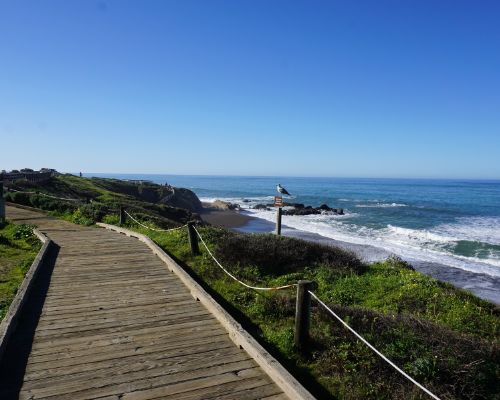
Memories mix with new discoveries when the writer visits his old stomping ground on the Central Coast.
I’ve been a little reluctant to recommend my old stomping grounds to a larger audience as a place to visit, but then Smithsonian magazine just named Cambria one of the “Top 15 Small Towns to Visit.” So, the cat is out of the bag. And with the reopening of Hearst Castle in May, after a two-year closure due to COVID and road repair, the crowds will swell in Cambria and San Simeon this summer anyway, peaking with the Labor Day weekend celebration called Pinedorado, which includes a parade down Main Street that is both delightfully campy and a sentimental throwback to old Americana. At Pinedorado grounds, locals and visitors mix at a Santa Maria-style barbecue, a beer garden and booths with carnival games for the kids.
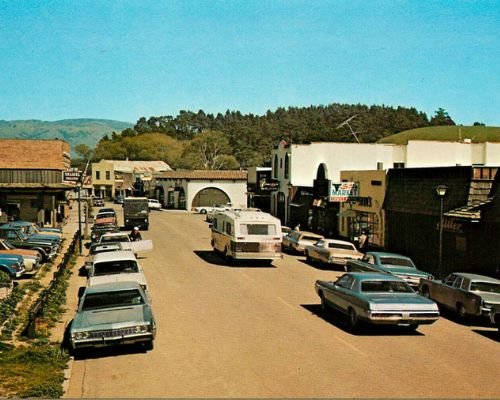

As a teenager in the ‘70s, Cambria’s Monterey pines, its creeks and rocky shores were my playground. On summer days, I caught fish and poison oak. For kicks, my two sisters and I had tree swings. My dad, an expert tree climber and general contractor, tied a rope to 100-foot Monterey pine on our hillside property, creating a daring, swooping swing for us. Thankfully it never broke or we would have been launched at a high arc down the hill toward the grammar school. These days my exploits in the area, when my wife and I visit, are slightly more refined: wine tasting, dining, shoreline walks, and occasional brushes with Cambria arts and culture. It’s our romantic getaway, but Cambria is also a great place to travel with children who are at the age when they are ready to walk easy trails, poke around tide pools, search for moonstones on Moonstone Beach, catch their first fish on San Simeon pier, spot wildlife, and soak up a little early-California history. On the shore, otters feed in small coves, and a rookery of elephant seals can be witnessed from a short bluff, a few miles north of San Simeon. Wild turkeys are plentiful, as are mule deer. I know this because my dad texts me pictures of his wildlife visitors from his house in Cambria (Yep, he still lives and works there as a general contractor).
EAST VILLAGE: ‘GIT ‘EM, OLE’
If you haven’t heard of Cambria, it’s 250 miles north of OC. It’s “Where the Pines Meet the Sea,” as the t-shirts say. It’s the first place you’ll see Monterey Pines as you head north on Highway 1, along the coast (I like the more scenic coastal route up rather than Interstate 5). It’s easy to blow past Cambria, as the downtown itself is a couple of miles off the highway and down a hill, which makes it all the better, since you drop down and throttle back literally and figuratively when you get to Main Street. In this part of town, set against the banks of Santa Rosa Creek, East Cambria has more historic buildings, which spread up and down Bridge Street, and on Burton Drive, newer buildings of shops and galleries done in the Victorian style of the historic Squibb House there.
In the late 1800s, Cambria was growing fast, with lumber, ranching, whaling and quicksilver mining operations. According to the Cambria Historical Society, buildings and houses were quickly raised with rough-hewn slabs of pine, sawed off by a horse-powered, then a steam-powered mill, and the town got the name Slabtown, based on the original appearance of the village. The name “Cambria” came from a land surveyor from Cambria County, Pennsylvania. Industry spiked in Cambria when Swiss dairymen came to the area in the 1880s. By the turn of the century, Cambria was shipping over a ton of butter per day to San Francisco via the wharf at San Simeon. The Squibb House on Burton, built in the 1880s, is now a quaint B&B, but in the ‘70s, it was a residence, and Old Mr. (Paul) Squibb used to pay us local kids a penny a minute to rake up the leaves around his place. Much of the history of Cambria was preserved by Squibb through his interviews with original-family descendants. A conservationist, Squibb scribbled his notes on the back of bank statements and print advertisements. The Cambria Historical Society, housed in East Village at the museum inside the Guthrie-Bianchini House, maintains a Paul Squibb collection of notes, along with recollections from other residents. You’ll also find in East Village, Mozzi’s Saloon, the last of Cambria’s cowboy bars.
In the late 1860s, when Cambria was a boomtown, there were 5 such taverns in a two-block stretch of East Village. Mozzi’s was called Old Camozzi’s for decades, named after the family that ran it starting in 1922. The floor is warped from spilled beer, forming a hump in what becomes the middle of the dance floor on Saturday nights. Bunyanesque stories are set at Mozzi’s, tales that get taller with each telling, but basically all end with rancher Eddie yelling to his brother, “Git ‘em, Ole,” and legendary cattleman Ole picking up the hapless troublemaker/biker/out-of-towner like a bail of hay, hurling him out through the front window in a rain of glass. Despite the stories, Mozzi’s is friendly to visitors, and Ole doesn’t throw people anymore. I would recommend the Cambria Museum as a first stop when you get into East Village, which will give you a primer on the many historic buildings.
There is a good variety of family-friendly dining options in East Village, serving pizza, Mexican and Mediterranean food. Among the best are…
Linn’s Restaurant—Located in the historic Bank of America building, with friendly servers and American comfort food, like pot pie and soups, with local fresh ingredients: Hearst beef, and Olallieberry pie from Linn’s own berries on their farm on Santa Rosa Creek Road. This place is my favorite for breakfast, but they also serve a great lunch and dinner. www.linnsfruitbin.com
Robin’s—A favorite of ours, and easily one of the best restaurants in the north Central Coast, Robin’s is in an old adobe house, with a beautifully lit garden that turns night dining into a romantic interlude. Local fresh ingredients are prepared in eclectic dishes like Brazilian seafood stew, next to American classics, like pan-seared salmon. Lunch and dinner, and a kids menu. www.robinsrestaurant.com
Work off the good eats with a nice walk along the bluff trail at Fiscalini Ranch Preserve, a 430-acre park accessible over on the ocean side of the hill from East Village, set between two residential neighborhoods: Lodge Hill and Park Hill. The Preserve extends from dramatic ocean bluffs that run more than a mile along the shoreline, through a grassy marine terrace, rising inland to a forested ridge with views of migrating whales, birds, and otters. The views are awe-inspiring, and whimsical benches made of driftwood remind you to relax and slow down along the way. www.fiscaliniranchpreserve.org.
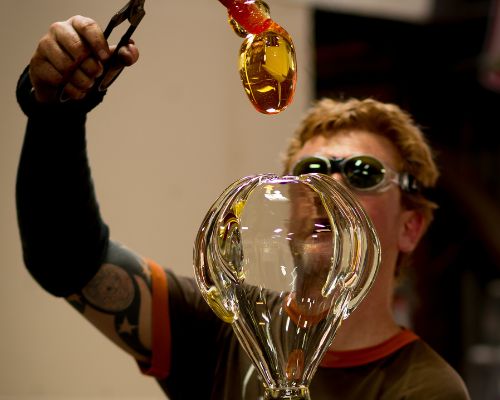
HARMONY: HE BLEW IT!
Just a few miles to the south of Cambria is the micro town of Harmony. With a population of 18 (9 people and 9 cows), Harmony was originally built around dairy ranches and a creamery that employed as many as 10 workers in its heyday, making purified butter in the old-world Swiss way: by clarifying it. The creamery closed in 1955, and Harmony re-invented itself in the ‘70s, becoming a haven for local artisans. The creamery was restored and shops opened. Today, Harmony Pottery and Harmony Glassworks keep the artistry in Harmony. Harmony Glassworks occupies part of the old Harmony Creamery plant. Instead of churning butter, they are blowing molten glass into art. Founded in 2007 by artist Eric Dandurand, Glassworks is a studio, a gallery and a school where the art of glass blowing is shared with the public. Some of the best glass artists in the world create here, and their gallery offers colorful, often stunning glassworks for purchase, from $5 marbles to $800 vases by Dandurand. When we came to the studio, visitors were able to create their own vase or bowl for a fee, with the guidance of a Glassworks artist. You’re probably thinking, me? With molten glass, a blazing furnace and a steel pipe? What could go wrong? Well, I’m happy to report that one of my clan, my son Shane, blew a bowl like a pro and survived. Maybe there’s something about the perceived danger that gives one a steady hand, but his bowl is a work of art that could easily pass as the creation of a master. As of press time, Dandurand had not yet resumed lessons to the public due to staff shortage, but he may soon, so call ahead and find out. Either way, as a spectator or participant, the glass-blowing will blow your mind. www.harmonyglassworks.com.
There is no better way to wind down from a glass-blowing studio than to lift a glass of the grape at Harmony Cellars, which offers a hilltop wine-sipping garden that overlooks the town of Harmony and miles of rolling pastureland surrounding the valley. Winemaker Chuck Mulligan offers Chardonnay, Pinot Gris, Riesling, Cabernet, spicy Zins and Port. Check their website for live music on Friday at twilight, and winemaker dinners. www.harmonycellars.com.
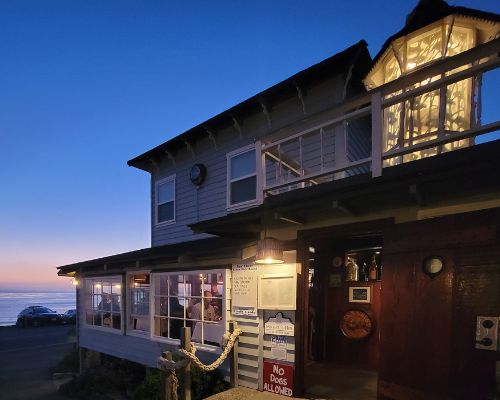
MOONSTONE BEACH: EMOTIONAL SUNSETS
The preferred oceanfront place to stay in Cambria is on Moonstone Beach. Choose one from a string of small inns that line Moonstone Beach Drive. We like the Pelican Inn and Suites for its large rooms (and because I proposed to my wife there), but all of the inns along this stretch have unobstructed white-water views of the rocky shoreline, and they sit across the two-lane road from the boardwalk on the bluff. The boardwalk is the best reason to stay on Moonstone Beach. It has multiple access points, so you can jump on from almost any inn, simply by crossing the road. For an out-and-back walk of 2.85 miles, start at the parking lot next to the lagoon at the mouth of Santa Rosa Creek. With only 40 feet of elevation over a smooth, uninterrupted surface, this is a walk anyone can do. It parallels Moonstone Beach Drive, offering several benches, wider vista points, and steps down to the beach along the way if you would like to explore the tidal pools, and why not? Hunt for moonstones (the smooth opalescent rocks from which the beach gets its name), make friends with anemones, and take your time to observe the ground squirrels, otters, seals, gulls, egrets, and, in the winter months, migrating gray whales in the distance. The sunsets from here are emotional. Leashed dogs are welcome on the boardwalk, but no bikes.
From your inn on Moonstone Beach, it’s an easy walk to two different memorable restaurants: The Sea Chest Oyster Bar and Moonstone Beach Bar & Grill. Two things you should know about the Sea Chest before you go: they take only cash (no cards) and seating is first-come, first-serve. This means the Sea Chest experience begins when you get in line outside in the parking lot. Most diners bring their own bottle of wine and cups for the line. Friends are made and even the ocean view from the parking lot is amazing. Big portions, fresh fish, simply cooked, with great service. There’s a kids menu too. www.seachestoysterbar.com
Serving lunch, dinner and Sunday brunch, Moonstone Beach Bar & Grill has such an amazing ocean-view patio, they don’t have to have great food, but they do, and there’s a good kids menu too. If you want a Bloody Mary with your brunch, they’ve got you covered, because they have the only full bar on this neck of the coast. Dishes incorporate local, fresh ingredients into steak, lamb, fish, chicken and pork. But the hallmark of this place is the best ocean view dining in Cambria. www.moonstonebeach.com
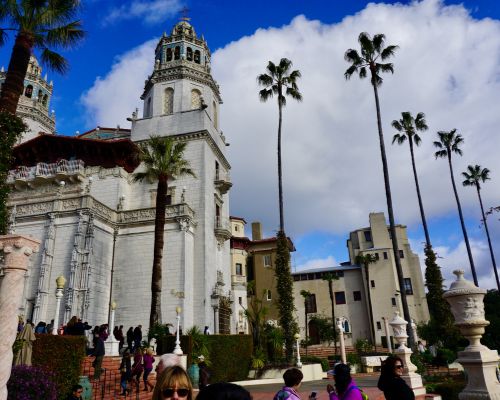
SAN SIMEON: WINE, SEALS AND A CASTLE
Six miles north of Cambria, Hearst Castle remains the area’s biggest magnet for tourists from around the world. But the Hearst Corporation is also credited with preserving this pristine stretch of coast by locking up the land, and donating plots for public use as a state park upon the passing of William Randolph Hearst in 1951. The beach and the forested point with gorgeous trails are all courtesy of Hearst. Tours of the castle closed for two years due to COVID, but reopened in May, just in time to celebrate the 150th anniversary of the birth of its architect, Julia Morgan. A new tour has been added to showcase her design genius and artistry. With 165 rooms and 123 acres of gardens, the castle offers so many different looks—decadent pools, palatial grounds and luxurious interiors, all punctuated with ancient art. Don’t forget to look up at the ceilings. Do see the IMAX movie of the publisher’s life before you tour. www.hearstcastle.org.
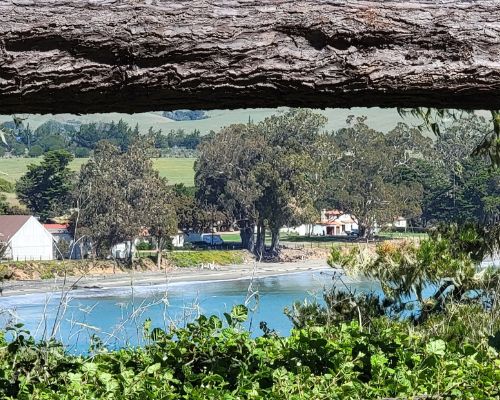
After a castle tour or a hike to the tip of San Simeon point and back, settle in for a wine tasting at Hearst Ranch Winery’s tasting garden on a bluff adjacent to the beach. Dog friendly picnic tables overlook the breathtaking cove, and pours of varietals or Randolph Red are paired with the soothing sound of gentle waves and the whisper of a breeze through the eucalyptus grove. There is plenty of seating inside as well, in the tasting room that was once a Hearst warehouse. The food truck isn’t always on the scene, but the friendly management allows you to bring your own picnic basket. www.hearstranchwinery.com.
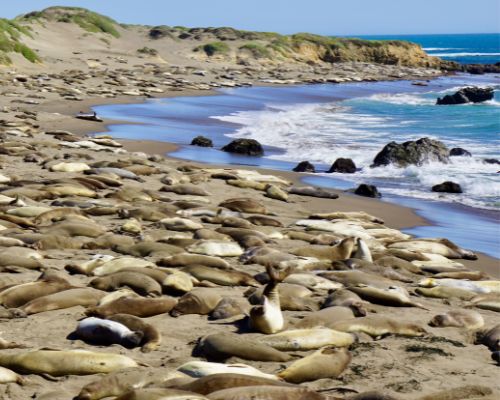
When you visit san Simeon, make sure to fit in a stop at the rookery of elephant seals, located 5 miles north of Hearst Castle. Your kids will be amazed. Their numbers vary depending on the season but you’ll see seals this summer. From October through March, the population of these huge, loud and fascinating creatures swells to 17,000. www.elephantseal.org.
Written & Photographed by Randall Tierney

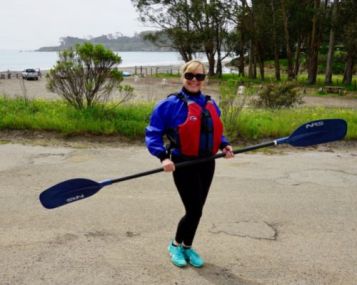

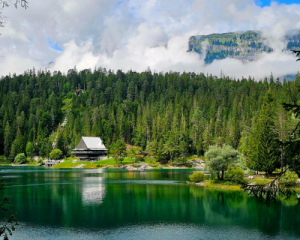

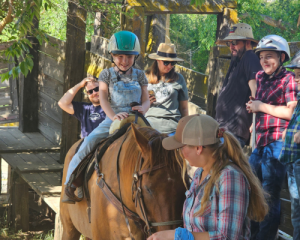

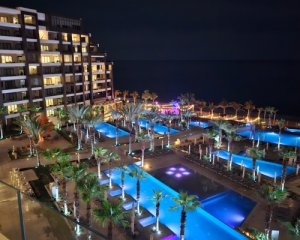


Cinder says
So much great information and I loved the personal touch… Cambria is a very special memory for me!!!
I can’t wait to try any and all the wonderful places you mention!!!
Thanks
Great job Randy👍👍
Can’t wait for further updstes…
Lisa P says
Wonderful article Randy! Makes me want to go back for a visit.